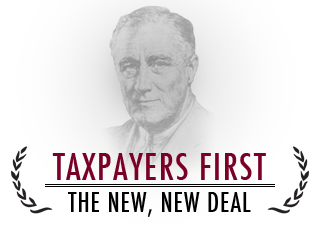Commentary

Taxpayers First: The New, New Deal
Today, the average government employee enjoys better health care benefits, better pensions, better job security, and an earlier retirement than the average private-sector worker. To pay for this, however, taxpayers have been strapped with unfunded liabilities that are poised to raise state and local taxes by billions of dollars in just a few years.
Some members in the Pennsylvania legislature recognize the problem of public-sector unionism and have proposed the Pennsylvania Open Workforce Initiative (House Bills 50-53). In addition to freeing workers from being forced to pay union dues as a condition of employment—like 22 other states have done—the package of bills would begin to pry loose the fingers of organized labor’s stranglehold on taxpayers.
It begs some questions: How did we get here and should taxpayers support measures like HB 50-53?
As for the journey here, although the American labor union movement began in the private sector in the late 1860s, the unionization of government employees wasn’t legally permitted in Pennsylvania until 1970. For more than a century, everyone—yes, everyone, including union-friendly FDR and private-sector labor union leaders themselves—argued that collective bargaining wouldn’t work in the public sector.
In 1937, Roosevelt said “the process of collective bargaining … cannot be transplanted into public service” because a strike by government employees was “unthinkable and intolerable.” AFL-CIO president George Meany said in 1955, “It is impossible to bargain collectively with the government.” And in 1959-the same year Wisconsin became the first to allow state public employees to unionize-the AFL-CIO Executive Council declared, “In terms of accepted collective bargaining procedures, government workers have no right beyond the authority to petition Congress—a right available to every citizen.”
Opposition to allowing the public sector to unionize stemmed from the recognition of the important differences between the public and private sectors. Private-sector unions bargain over how much unionized employees should share in the profits of a business. Profits are limited, and the existence of competition from others moderates unreasonable demands for higher wages and benefits.
Government, on the other hand, earns no profits, and has no competition. It is a monopoly. Therefore, public-sector unions—gaining a monopoly over the government workforce—can only negotiate over tax dollars. And the lack of competition allows public-sector unions the power to deprive citizens of essential government services, such as public safety, mass transit, and education, when union demands are not met at the bargaining table.
Opposition to public-sector unionism began to wane in the 1950s when private-sector unions began their precipitous decline that continues to this day. In Pennsylvania, while Pennsylvania added nearly one million more jobs between 1983 and 2009, private-sector union membership dropped from 855,000 to 430,000 workers. Today, only nine percent of private-sector employees work in a union shop, while 53 percent of Pennsylvania’s government employees are in a collective bargaining unit.
As predicted, public-sector unionization has effectively raised the cost of public services for taxpayers. In 1991, Pennsylvania’s state and local tax burden was 24th in the nation. Today, it is the 10th highest. Granting unions a monopoly over the government workforce has given them significant leverage over budgets and taxes. Unions use the power of compulsory union dues to lobby for higher taxes, more government jobs, and increased compensation.
Pennsylvania’s two statewide pension funds for public employees—the Public School Employees Retirement System (PSERS) for public school workers and the State Employees Retirement System (SERS) for state workers, legislators, staff, and judges—have funding deficits of $31 billion and $11 billion, respectively. Unfortunately, due to political manipulations to the systems last fall, PSERS’s unfunded liabilities alone are projected to reach close to $50 billion by 2020, before it begins to decrease.
Moreover, while the private sector in Pennsylvania has lost 124,000 jobs since 2000, state and local governments added 39,000. The biggest increases were in the heavily unionized public schools that added nearly 33,000 jobs despite losing almost 27,000 students. In what industry other than government would you lose “customers” and still be adding employees?
While none of these proposed bills would end public-sector unionism entirely, they would go a long way towards curbing the special financial privileges enjoyed only by labor unions. It is past time we recognized this 40-year experiment with public sector unionism hasn’t worked for anyone but special interests and embrace a new, New Deal that puts taxpayers first.
# # #
Matthew J. Brouillette is president and CEO of the Commonwealth Foundation (www.CommonwealthFoundation.org), an independent, nonprofit public policy research and educational institute based in Harrisburg.